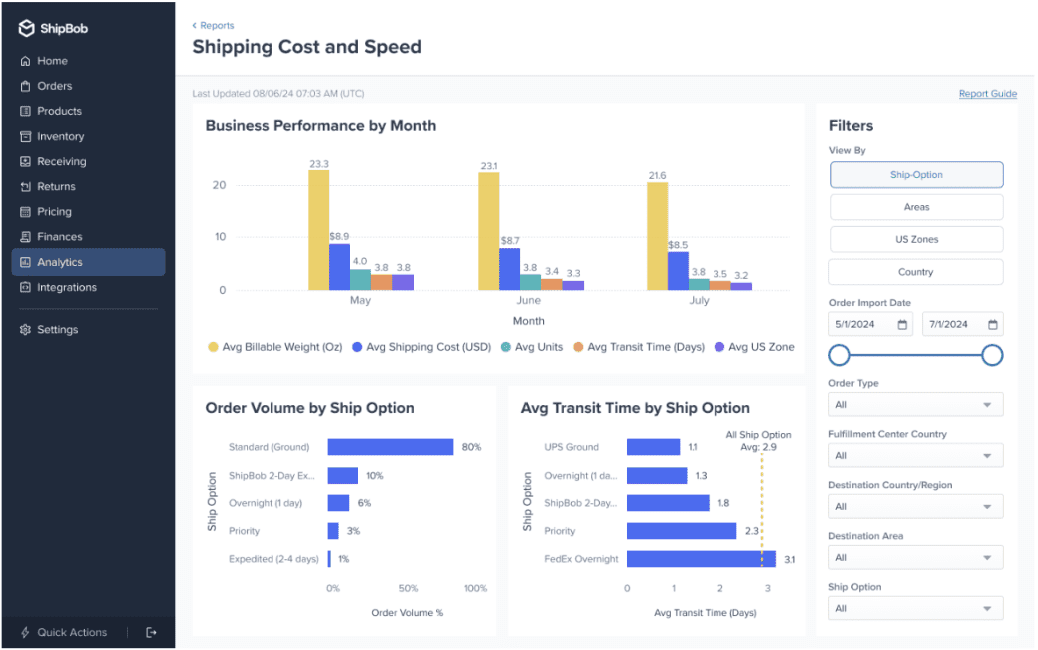Verified & Reviewed
Published on August 4, 2025 Written By Rachel Hand

Published on August 4, 2025 Written By Rachel Hand
Subscribe for More
With its powerful ecommerce tools and intuitive interface, having a Shopify store is one way to gain a competitive edge.
However, things have to be equally smooth on the backend so customers can enjoy a fulfillment experience that’s just as effortless as shopping on your website. That’s why, if you manage fulfillment in-house, you need a warehouse management system (WMS) that seamlessly integrates with your Shopify store.
In this guide, we’ll take a closer look at Shopify warehouse management system integrations and share what features to look for when selecting a Shopify WMS solution.
Why sellers should integrate a warehouse management system with Shopify
When you integrate a WMS with your Shopify store, you connect your external storefront with your behind-the-scenes warehouse operations. By connecting the two, you make sure that they sync. That way, when something happens on one side of your business, it also affects the other side.
This connection is very beneficial for ecommerce businesses, for several reasons:
Next-level operational efficiency improvements
A warehouse management system (WMS) makes your logistics operations more efficient. Specifically, a WMS:
- Gives you real-time inventory information at a glance, saving you time and effort.
- Builds multiple checks and balances into the fulfillment process, so your team gets it right the first time and avoids costly rework.
- Syncs automatically with your Shopify store so you don’t have to enter the same information twice, which cuts down on mistakes and keeps everything accurate.
- Optimizes picking and putaway routes to reduce travel time and labor costs.
Automated order processing and fulfillment
With your Shopify store and WMS integrated, you can automate a lot of the daily grind of logistics, like:
- Order Confirmation: With an integration, orders automatically flow from your Shopify store to the WMS. This means that as soon as someone places an order on your website, that order is recorded and pushed into your fulfillment queue. It’s instantaneous, and saves you the trouble of manually logging every order yourself.
- Order Processing: An integrated WMS can pull order and customer data directly from your Shopify store, so you don’t have to it put in details like names, addresses, and zip codes yourself. Automating this piece lowers the risk of human error, reducing misshipments while improving order accuracy.
- Order Routing: A WMS that has smart order routing capabilities can automatically process order data and forward each order to the most ideal fulfillment center. This ensures that each order is shipped out from the nearest fulfillment center, which minimizes shipping costs and times for customers.
Real-time inventory visibility across channels
Integrating your Shopify store and WMS lets you sync order and inventory data across all your warehouses and sales channels. This gives you real-time inventory visibility, so you can get an accurate idea of stock availability at all times. That way, you can see when you’re running out of stock and make timely replenishment orders to avoid stockouts.
Moreover, accurate visibility into your inventory levels and sales patterns will help you with accurate demand forecasting. You can anticipate your inventory needs and plan your replenishment strategically to minimize the risk of stockouts or understocking, and keep the optimal amount of inventory on hand at all times.
Happier customers and faster growth
Stockouts and backorders are huge disappointments for eager shoppers. With a WMS integration, you can sync your warehouse’s inventory counts to your Shopify store (and other channels) to monitor levels and reorder before you run out of stock. If you do run out, the integration feeds that information back to your store to shut off sales for that SKU, so you don’t sell more inventory than you actually have.
Customers also love fast and affordable shipping — and when you integrate your WMS to your Shopify store, you get access to multi-carrier shipping options. This makes it easy to compare shipping rates and transit times across different carriers, so you can offer more shipping options and keep up with your delivery promises. It even lets you opt for faster shipping to ensure timely deliveries and improve the customer experience.
“Onboarding with ShipBob’s WMS was our first time connecting to a warehouse management system, so we had to get data and SKUs synced with the platform, do warehouse mapping, and get our various integrations (like Shopify and NetSuite) set up. Once everything was in place, we just had to flip a switch to start fulfilling orders. The ShipBob team even came out to our facility for a week to show us how to do everything. It was a super straightforward process. It’s a very plug-and-play solution that is also customizable to our workflows.”
Jourdan Davis, Operations Manager at Pit Viper
5 essential features of a reliable WMS for Shopify
There are lots of warehouse management solutions on the market — so which do you choose?
When answering that question, don’t get distracted by the bells and whistles. Instead, focus on your Shopify store’s needs, and whether a WMS that can do the most important tasks really well. Here are five of those essential WMS requirements that your brand should look for in a WMS.
1. Real-time inventory synchronization
As soon as something happens to inventory — whether it’s sold on your Shopify store, picked and packed in an order, or returned — a WMS should record that movement and update your inventory levels accordingly.
For example, a WMS like ShipBob enables bi-directional inventory syncing between Shopify and the system. In other words, our WMS tracks every movement of inventory, and updates sellable inventory counts in Shopify to reflect any activity automatically.
With inventory data automatically updated whenever inventory is sold, restocked, or used in fulfillment, you:
- Know exactly how much inventory you have, and can prevent accidental overselling.
- Have an accurate visibility of your real-time inventory levels at the SKU-level for better decision-making.
- Can forecast more accurately to time replenishment, and helps you avoid overstocking or stocking out.
2. Automated order processing
Your WMS should be able to automatically receive and process orders from your Shopify store.
Automated order processing is one of the best efficiency boosters for your ecommerce brand, because it:
- Drastically cuts down processing time and speeds up your order fulfillment.
- Collects order data directly from Shopify, reducing the risk of human error and improving fulfillment accuracy.
- Prioritizes and routes orders based on proximity to the edn customer and inventory availability to fulfill and ship each order from the optimal fulfillment center, allowing for faster deliveries and lower shipping costs.
- Sends order status updates back to customers throughout the ecommerce fulfillment process, enhancing transparency and improving the overall customer experience.
3. Advanced picking and packing workflows
Your WMS must support advanced picking and packing workflows to streamline your Shopify fulfillment operations.
Whether it’s batch picking, wave picking, or zone picking, your WMS should have the flexibility to let you use the picking methodology that works best for your operation.
The WMS should also support paperless workflows for various picking strategies. ShipBob, for example, leverages barcoding labels and inventory scanners to quickly capture and verify inventory information during the picking process.
Not only does this sped up the picking process (since pickers don’t have to manually search for and check that they have the correct items), but it also updates your inventory counts in real time, ensuring that your inventory levels are as up-to-date as possible.
4. Multi-carrier shipping integrations
Your WMS should let you compare rates between multiple carriers to help you find the best deal.
When you can see which carriers offer the most affordable shipping option for each order, you can reduce shipping costs for individual orders and save a lot of money over hundreds of shipments.
ShipBob’s WMS, for example, compares different carrier rates for each unique shipment. Brands can also leverage the system’s built-in logic to automatically select the cheapest carrier for each order, based on their desired carrier panel.
In addition to multi-carrier shipping integrations, ShipBob’s WMS also supports:
- Automated label generation and shipping document creation (which streamlines the fulfillment workflow).
- Returns management capabilities, including integrations for leading returns solutions and preference settings for how to handle returns (i.e., whether to restock, quarantine, or dispose of items).
5. Multi-location and global fulfillment
Your WMS should offer a synchronized view of inventory, orders, and shipments across all fulfillment centers you use, including international ones.
Using more than one warehouse to store inventory and fulfill your ecommerce orders is the key to optimizing speed and cost savings. When you take a distributed inventory approach, it allows you to place inventory closer to more end customers. This helps you deliver more orders faster and reduce your average shipping cost.
Managing inventory across multiple locations can be complicated, but a WMS should make it simpler. With ShipBob’s WMS, for instance, you get cross-location visibility from a single platform, allowing you can see what’s going on across all these fulfillment locations (even global ones) and giving you accurate inventory counts at each place according to the latest activity. It can even report on your warehouse and inventory performance across these locations, enabling you to make informed decisions.
“We were doubling in size every year, adding thousands of SKUs as we developed our own clothing line – and at the rate we were scaling, our patchworked fulfillment solution just wasn’t cutting it. We were so busy, and trying to manage 3,500+ SKUs through Shopify alone was simply unsustainable. I knew we needed a more robust, comprehensive solution to support our operations at scale.
I thought my only option was outsourcing fulfillment and shipping completely, so I reached out to both ShipBob and one of their competitors. During my conversation with ShipBob, their team mentioned that that ShipBob actually offers its proprietary warehouse management software (WMS) as a standalone solution, so ecommerce brands can use it to power their own warehouses. I was thrilled! This meant that I could keep my existing warehouse facility, keep all my inventory where it was, and still optimize our warehouse operations. It was exactly what I was looking for.”
Tim Poyer, VP of Operations and Logistics at Elwood Clothing
ShipBob: The best, all-in-one WMS solution for Shopify merchants
If you’re looking for a Shopify-compatible warehouse management system that can do all of this and more, look no further than ShipBob’s WMS.
Shopify brands can use the same WMS that powers ShipBob’s dozens of fulfillment centers worldwide to optimize their own fulfillment operations.
Here are just some of the ways ShipBob’s WMS can streamline your logistics for your Shopify business.
Seamless Shopify integration in minutes
With direct integration capabilities, integrating ShipBob with your Shopify store is quick and easy. The setup process lets you integrate your store in just a few clicks, and supports a bidirectional data flow between the two platforms, allowing your order and inventory data to sync flawlessly.
When your ShipBob and Shopify platforms are connected, you unlock advanced features like:
- Automatic and real-time order syncing
- Unique Shopify-generated variant IDs to match Shopify products with inventory in ShipBob
- Real-time fulfillment tracking
Advanced fulfillment capabilities beyond standard WMS features
ShipBob’s proprietary WMS offers comprehensive features to support your fulfillment needs, including the essentials. ShipBob WMS:
- Serves as a single source of truth to manage all your warehousing tasks, inventory data, and order information, ensuring better accuracy.
- Syncs accurate inventory data across all your sales channels, including your Shopify store.
- Automates order processing from Shopify and other sales channels, kickstarting the fulfillment workflow once an order is placed.
- Determines the most optimal fulfillment center for each order and routes the order accordingly.
- Runs multiple checks and balances throughout the fulfillment process via barcoding and scanning systems.
- Optimizes various aspects of fulfillment workflows, including pick list generation to create the most efficient optimized picking routes that save time.
- Offers a powerful analytics and reporting suite that gives you comprehensive insights into your inventory and fulfillment performance across different locations, helping you pinpoint problem areas, identify bottlenecks, and come up with data-driven solutions to improve your performance.


Beyond these standard WMS capabilities, ShipBob also supports advanced fulfillment solutions. This includes value-added services like kitting, bundling, and custom packaging to enhance the customer unboxing experience.
Additionally, ShipBob’s WMS supports B2B and wholesale order fulfillment, enabling you to partner with retailers and scale beyond Shopify seamlessly. You can effectively process and fulfill Shopify B2B orders, with the option to add packing and special SKU instructions directly within the dashboard.
Global fulfillment network with centralized control
For businesses growing internationally, ShipBob offers an expansive network of fulfillment centers across multiple countries. Whether you’re selling to customers in Australia, Canada, Europe, or beyond, you can distribute your inventory across multiple strategic ShipBob locations.
This expansive fulfillment network enables you to deliver orders faster while cutting the cost of international shipping and reducing cross-border complexities. All of this contributes to a better customer experience while improving your bottom line.
Even when you’re managing a vast global operation, ShipBob WMS’s centralized dashboard helps you streamline the process and enhance visibility. You can easily see what’s going on at specific locations, replenish or redistribute inventory as needed, and more. This gives you better control overall your global fulfillment operations, resulting in greater efficiency and cost savings.

Inventory forecasting and demand planning for consistent excellence
With ShipBob’s WMS serving as a single source of truth for all your order and inventory data, you’ll get a comprehensive understanding of your demand patterns and inventory needs. This lets you forecast demand more accurately based on demand fluctuations and seasonal changes, which is crucial to avoid stockouts and overstocking.
It even lets you set automatic reorder point notifications, so whenever you’re running low on stock for a certain item, you can place timely replenishment orders to prevent stockouts.

Get started with ShipBob
Ready to get started with ShipBob for your Shopify store? The setup is easy. All you need to do is install ShipBob from the Shopify App Marketplace. Then sign into Shopify to complete the integration process.
Once integrated, go to your Shopify store from the ShipBob dashboard. This will let you manage the integration, with the option to change settings for products, inventory, fulfillment, and orders. You’ll want to sync your existing products from Shopify to ShipBob, which may take some time depending on how many products you have.
Follow our Shopify initial setup guide to manage other aspects of your integration.
Looking to outsource fulfillment? Click the button below to get in touch with our team of experts.
Shopify WMS integration FAQs
Below are answers to the most common questions about Shopify WMS integration.
Can I manage multiple warehouses with a single Shopify WMS integration?
Yes. A WMS like ShipBob’s lets you manage multiple warehouses from a single platform. You can distribute your inventory across multiple warehouses and use the WMS to maintain centralized visibility. This ensures that your inventory data is always updated based on new activity taking place across different locations, ensuring real-time accuracy.
How does a WMS improve inventory accuracy for Shopify stores?
A WMS should support barcode scanning capabilities, enabling warehouse staff to run multiple checks and balances as inventory moves through the fulfillment process, ensuring order accuracy. It should also capture inventory data and update it in real-time to improve inventory accuracy. Additionally, it should streamline cycle counting and inventory auditing, enabling you to maintain accurate inventory data.
What advanced picking and packing workflows can a WMS enable?
ShipBob’s WMS supports various picking methodologies such as batch picking, wave picking, and zone picking, so you can choose an approach that works for you. It generates optimized picking lists based on optimal picking routes to reduce travel time and improve picking efficiency.
Can a WMS support multi-channel selling beyond Shopify?
ShipBob’s WMS handles inventory across multiple sales channels, with integrations for leading marketplaces and ecommerce platforms. This lets you streamline multi-channel selling and optimizes visibility across all your sales channels.




